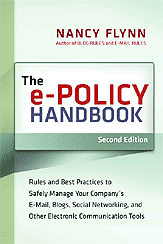|
2004 Survey on Workplace E-Mail and IM Reveals Unmanaged Risks
55% Lack Retention Policies, 21% of E-Mail Subpoenaed
New York, NY...Over one in five employers (21%) has had employee e-mail and instant messages
(IM) subpoenaed in the course of a lawsuit or regulatory investigation. That's more than double the 9%
reported in 2001, and a 7% increase over the 14% reported last year. Another 13% have battled workplace
lawsuits triggered by employee e-mail. Yet, in spite of the fact that e-mail and instant messages are a
primary source of evidence-the electronic equivalent of DNA evidence-employers remain largely ill-prepared
to manage e-mail and instant messaging risks. That's according to the new
2004 Workplace E-Mail and Instant Messaging Survey of 840 U.S. companies from American Management Association and The ePolicy Institute.
"Most alarming is the business community's failure to retain e-mail and IM according to written
retention and deletion policies," said Nancy Flynn, author of the best-practices guidebooks
Instant Messaging Rules (AMACOM Books 2004) and
E-Mail Rules (AMACOM Books 2003) and executive director of The ePolicy Institute (www.epolicyinstitute.com). Merely 6% of organizations retain and archive business record IM, and only 35% have an e-mail retention policy in place-a mere 1% increase over the 34% reported in 2003.
The failure to properly retain e-mail and IM reflects employers' failure to educate employees about e-mail and IM risks, rules, and policies. "The fact that 37% of respondents do not know or are unsure about the difference between an electronic business record that must be retained, versus an insignificant message that may be deleted, suggests that employers are dropping the ball when it comes to effectively managing e-mail and IM use," said Flynn. This year, 54% of respondents say their organizations conduct e-mail policy training, a 6% increase over the 48% reported in 2003.
While over a third of survey respondents are in the dark about business record retention, 42% perform a job function that is governed by government or industry regulations. Fully 43% of those regulated employees either do not adhere to regulatory requirements governing e-mail retention, or are unsure if they are in compliance. "For financial services firms and others in regulated industries, the failure to properly retain e-mail and IM can-and regularly does-lead to six-figure fines, criminal charges, civil lawsuits, and damaging publicity" said Flynn. "Employers simply cannot afford to approach e-mail and IM retention as a hit-or-miss proposition."
While employers have been slow to put e-mail and IM retention policies into place, fully 79% of employers have implemented a written e-mail policy. Unfortunately, only 20% have adopted a policy governing IM use and content.
The failure to impose written instant messaging rules and policies is particularly disturbing considering that only 11% of organizations employ IM gateway/management software to monitor, purge, retain, and otherwise control IM risks and use. With 31% of employees using IM at the office, and 78% of those users downloading free IM software from the Internet, 89% of organizations are vulnerable to a growing array of IM-related legal, compliance, productivity, and security threats-on top of a myriad of e-mail challenges they have yet to master.
Employers do a somewhat better job of monitoring employee e-mail than IM. Fully 60% use software to monitor external (incoming and outgoing) e-mail. But only 27% take advantage of technology tools to monitor internal e-mail conversations that take place between employees. "Management's failure to check internal e-mail is a potentially costly oversight. Off-the-cuff, casual e-mail conversations among employees are exactly the type of messages that tend to trigger lawsuits and arm litigators with damaging evidence," said Flynn.
When it comes to fast and loose content, nothing tops instant messaging. The majority (58%) of workplace users engage in personal IM chat. Survey respondents report sending and receiving the following types of inappropriate and potentially damaging IM content: attachments (19%); jokes, gossip, rumors, or disparaging remarks (16%); confidential information about the company, a coworker, or client (9%); sexual, romantic, or pornographic content (6%). From the standpoint of content and retention, employers should view IM as a form of turbocharged e-mail, creating a written business record that must be monitored and managed. Employers are advised to take control of instant messaging risks today, or face potentially costly consequences tomorrow.
For employers concerned about employee productivity, the
2004 Workplace E-Mail and Instant Messaging Survey reveals that 90% of respondents spend up to 90 minutes per workday on IM. Another 10% of employees spend more than half the workday (4-plus hours) on e-mail, with 86% engaged in personal correspondence. Spam continues to plague organizations, with 12% reporting that more than half the e-mail they receive at work is spam.
Employers are getting tougher about e-mail policy compliance, with 25% of 2004 respondents terminating an employee for violating e-mail policy, versus 22% in 2003 and 17% in 2001.
As detailed in Flynn's new book Instant Messaging Rules, there is no such thing as a risk-free e-mail and IM environment. Fortunately, by developing and implementing a strategic e-mail and IM management program that combines written policy with education and enforcement, employers can anticipate e-mail and IM disasters, address employee misuse, derail intentional abuse, and limit costly liabilities.
The 2004 Workplace E-Mail and Instant Messaging Survey is co-sponsored by American
Management Association and The ePolicy Institute. Survey summary, interviews, photos, and e-mail
and IM disaster stories available upon request. Media wishing to receive a review copy of Instant
Messaging Rules: A Business Guide to Managing Policies, Security, and Legal Issues for Safe IM
Communication (Nancy Flynn, AMACOM Books, 2004), should contact Amacom's Irene Majuk
(212/903-8087 or imajuk@amanet.org). Contact AMA's Roger Kelleher (212/903-7976 or
rkelleher@amanet.org) for
survey process. The ePolicy Institute's Nancy Flynn (614/451-3200 or
nancy@epolicyinstitute.com) for e-mail
and IM policy and workplace best practices.
Note to Editors: Author and ePolicy expert Nancy Flynn is available
for interviews. Phone 614/451-3200 or e-mail Nancy@ePolicyInstitute.com.
View the complete 2003 ePolicies and ePractices Survey online at www.epolicyinstitute.com. Review copies of The ePolicy Handbook (Amacom, 2001) and Writing Effective E-Mail (Crisp, 1998) available upon request.

©Copyright 2002, 2003, The ePolicy Institute. All content is the property
of The ePolicy Institute. Visitors may reprint or repost content for
non-commercial use only, provided the following citation is included:
2002, 2003 The ePolicy Institute, Executive Director Nancy Flynn,
e-mail experts@epolicyinstitute.com.
The ePolicy Institute
2300 Walhaven Ct., Suite 200A
Columbus, OH 43220
614/451-3200 (phone) 614/451-8726 (fax)
experts@epolicyinstitute.com
|





